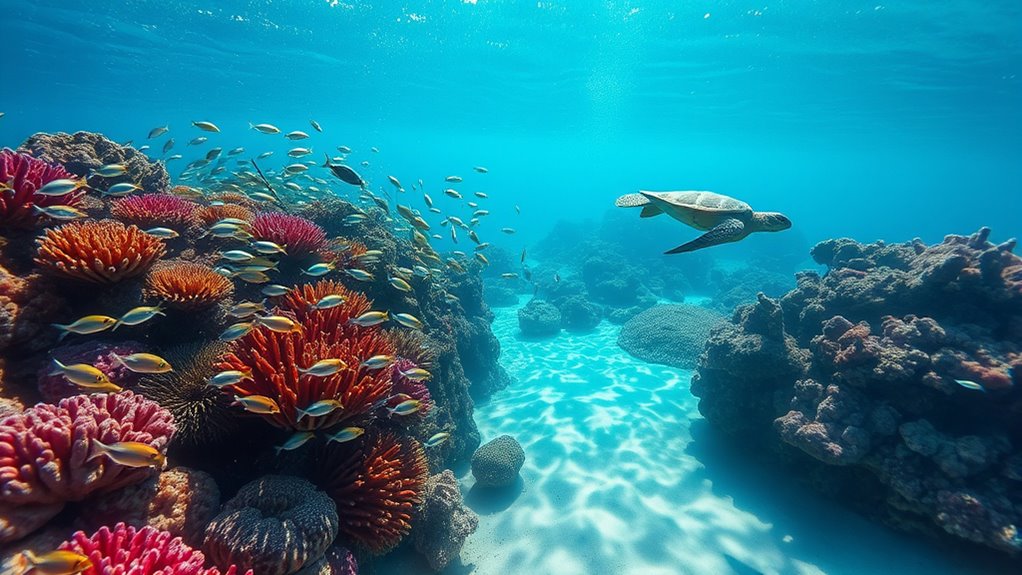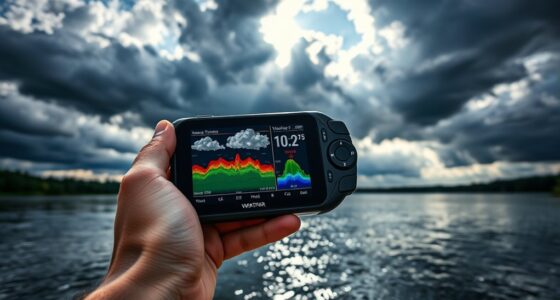When observing marine life, move slowly and keep your distance to avoid startling creatures. Refrain from touching or grabbing animals, and use gentle movements if you need to reposition yourself. Respect their habitats by not touching corals or feeding animals. Stay aware of your surroundings, maintain a safe space, and support eco-friendly practices. If you follow these guidelines, you’ll enjoy the underwater world responsibly and learn more about how to protect it every step of the way.
Key Takeaways
- Move slowly and calmly to avoid startling marine creatures.
- Maintain a safe distance of several feet from animals during observation.
- Refrain from touching, grabbing, or feeding marine life to prevent disrupting natural behaviors.
- Use gentle movements and stay neutrally buoyant to minimize ecosystem disturbance.
- Respect habitats by avoiding coral contact and sticking to designated paths.
Understanding Marine Life Behavior and Habitats
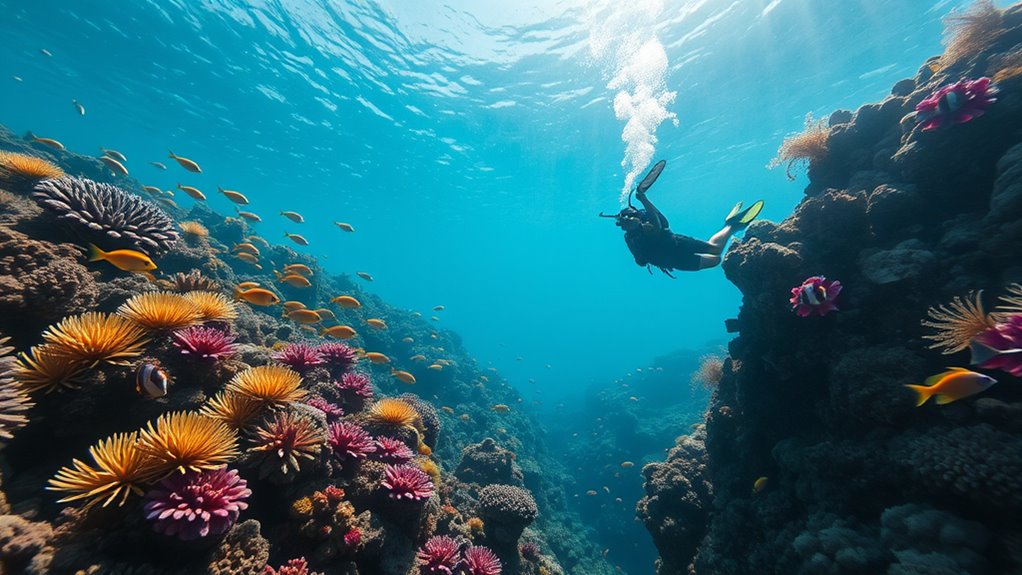
To truly appreciate marine life, you need to understand their behaviors and habitats. Marine creatures have unique routines and environments that keep them thriving. For instance, some fish are territorial, staying close to specific coral formations, while others migrate seasonally across vast distances. Recognizing these patterns helps you anticipate where they might be and how they behave. Different habitats, like coral reefs, kelp forests, and deep-sea trenches, host distinct communities with specific adaptations. By learning about these environments, you avoid disrupting delicate ecosystems. Pay attention to how species interact, feed, and move. This knowledge allows you to observe without interfering, ensuring your presence remains unobtrusive and respectful of their natural routines. Understanding marine ecosystem dynamics and how species adapt to their surroundings enhances our ability to study and protect these ecosystems effectively.
Approaching Marine Creatures Respectfully
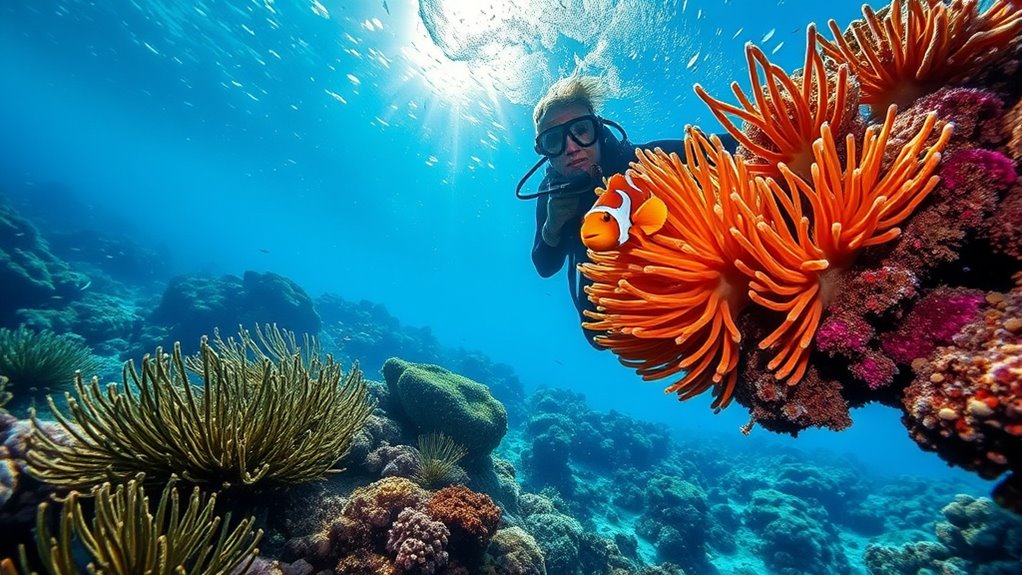
Approaching marine creatures with respect is essential to preserving their natural behavior and environment. You should move slowly and calmly, avoiding sudden movements that could startle or stress them. Keep your hands to yourself and refrain from touching or grabbing any animals; this can cause harm and disrupt their routines. Use gentle fins or controlled movements if you need to change position, ensuring you don’t invade their space. Pay attention to their responses—if they appear uncomfortable or retreat, give them space. Remember, they’re not objects for your entertainment but living beings that deserve your respect. By approaching with patience and care, you help protect their well-being and maintain the delicate balance of marine ecosystems.
Maintaining Proper Distance and Movement Techniques
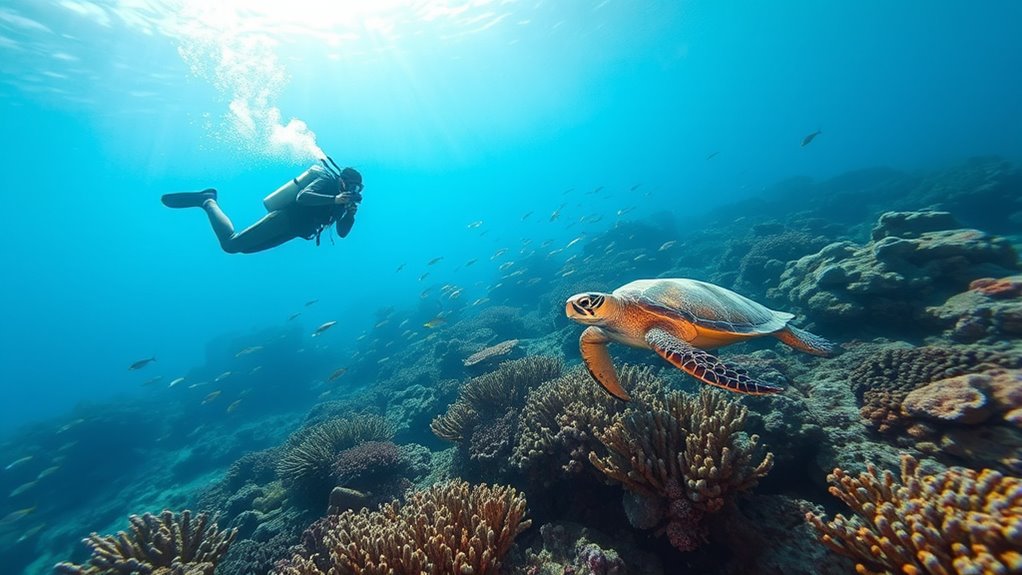
Keeping a respectful distance from marine life and moving carefully helps prevent unnecessary stress or disturbance. Maintain at least a few feet distance from creatures, avoiding sudden movements or quick approaches. Use slow, deliberate motions to minimize disruption and give animals time to adjust to your presence. Keep your fins or camera steady, and avoid touching or grabbing anything in the water. When you turn or change direction, do so gradually. Be mindful of your buoyancy—stay neutral to avoid unintentionally drifting closer or closer to marine animals. Regularly check your surroundings to ensure you’re not encroaching on their space. Being aware of your projector technology settings can help you maintain optimal visibility and prevent distractions during observation. Additionally, understanding marine life behavior can help you anticipate their responses and further reduce disturbances. Practicing environmental awareness enhances your ability to observe responsibly. By controlling your movements and respecting boundaries, you help preserve the natural behavior and well-being of marine life. Incorporating AI-powered tools can assist divers in maintaining safe distances through real-time feedback. Recognizing the importance of regulations and guidelines ensures that your activities align with conservation efforts and legal requirements.
Responsible Interaction With Marine Ecosystems
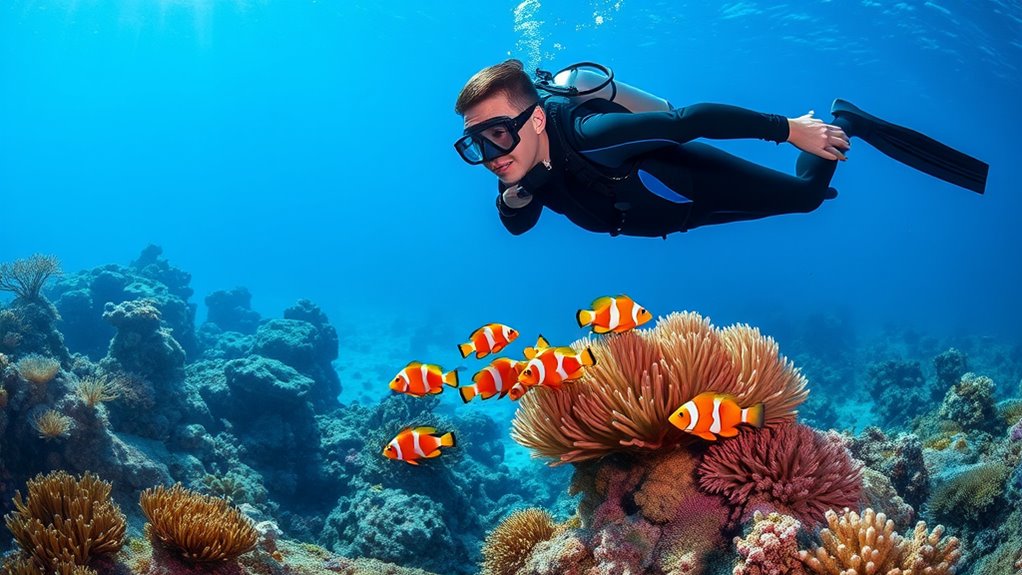
Understanding how your actions impact marine ecosystems is essential for responsible diving and snorkeling. When you interact thoughtfully, you help protect fragile habitats and preserve marine life for future generations. Avoid touching corals, as oils and physical contact can cause damage that takes years to recover. Refrain from feeding fish or other creatures, since this alters their natural behaviors and diets. Be mindful of where you swim—don’t stand on or kick up sediment that can smother coral and reduce water quality. Keep your movements gentle and deliberate to minimize disturbance. Respect marine life by observing from a distance, allowing animals to go about their routines undisturbed. Practicing mindfulness while observing marine life minimizes disturbance and promotes respectful interactions. Incorporating environmental awareness into your activities ensures that your actions support healthy ecosystems and that marine environments remain vibrant and resilient for everyone to enjoy. Developing a sense of empathy for marine creatures helps foster a deeper appreciation and commitment to their preservation. Being aware of auditory processing challenges can help you better understand how sound influences marine animals and adapt your behavior accordingly. Additionally, recognizing the importance of public engagement can motivate others to adopt responsible practices and contribute to marine conservation efforts. Your responsible behavior supports healthy ecosystems and ensures everyone can enjoy the beauty beneath the waves.
Tips for Sustainable Snorkeling and Diving Practices
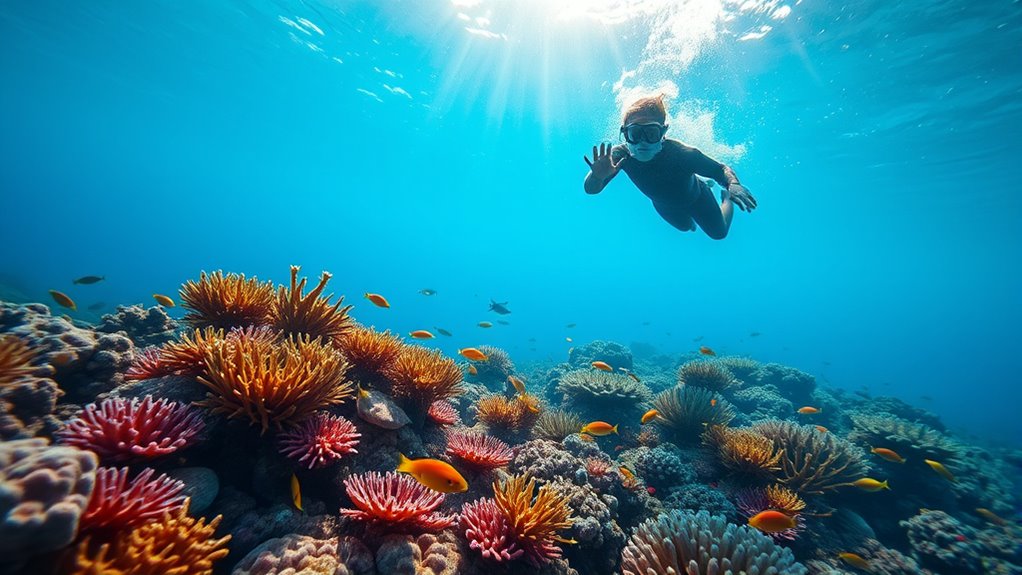
To guarantee your snorkeling and diving activities are sustainable, prioritize minimizing your environmental impact at every opportunity. Always maintain a safe distance from marine life, avoiding touching or chasing animals, which can stress or harm them. Use eco-friendly sunscreen to prevent chemical pollution that can damage coral reefs. Stick to designated paths and avoid kicking up sediment, which can smother delicate ecosystems. Choose dive operators committed to conservation practices, and consider supporting marine protected areas. Limit your time in sensitive habitats to reduce disturbance. Never collect souvenirs or take marine life with you; observe and appreciate instead. Be aware of the importance of archiving in preserving the knowledge of marine ecosystems for future generations. Proper marine habitat protection ensures these ecosystems remain resilient and vibrant for years to come. Incorporating public awareness and education about marine conservation can further enhance the sustainability of your activities. By practicing responsible behavior, you help preserve marine ecosystems for future generations and ensure your adventures remain eco-friendly and enriching.
Frequently Asked Questions
What Should I Do if I Accidentally Touch Marine Animals?
If you accidentally touch marine animals, stay calm and gently remove yourself from the area. Avoid further contact to prevent stressing or harming the creature. It’s important to wash your hands thoroughly afterward to protect both yourself and marine life from potential bacteria or chemicals. Remember to be more mindful in the future; respecting their space helps preserve their natural behavior and ensures a safe experience for everyone involved.
Are There Specific Signs to Look for Indicating Marine Animals Are Stressed?
When observing marine animals, you want to recognize signs of stress to avoid disturbing them. Look for rapid swimming, hiding, or sudden changes in behavior, like tail flicks or gill movement. If you notice these signs, you should back away calmly and give the animal space. Respect their natural behavior, stay at a safe distance, and minimize your movements to guarantee you don’t cause unnecessary stress or harm.
How Can I Identify Protected or Endangered Marine Species?
They say “knowledge is power,” and knowing how to spot protected or endangered marine species is key. Look for distinct features like unique markings, size, or coloration that set them apart from common species. Check local guidelines or signage at dive sites, and consider using identification guides or apps. By staying informed, you can enjoy marine life responsibly and help protect our precious ocean ecosystems.
What Equipment Is Best for Minimizing Disturbance During Underwater Observation?
You want to minimize disturbance during underwater observation, so choose quiet, non-intrusive equipment. Use a snorkel or scuba gear with a low-noise regulator, and opt for a camera with a wide-angle lens to keep your distance. Wear neutral-colored wetsuits to blend in with the surroundings. Maintain slow, deliberate movements, and avoid touching or chasing marine life. This approach guarantees you observe without causing stress or harm to the creatures.
Can Marine Life Recognize Human Presence and Remember Individual Divers?
Imagine marine creatures with memories so sharp they can recognize you across vast ocean distances! While some fish and mammals do remember individual humans, it’s rare for them to do so consistently. Your presence might be noticed, but if you practice respectful diving and maintain a calm, non-intrusive approach, you’ll minimize disturbance. Over time, animals may become accustomed to your presence, but they likely won’t remember you long-term.
Conclusion
By respecting marine life and their habitats, you guarantee these incredible ecosystems thrive for generations to come. Remember, your actions can either harm or help these delicate environments—are you willing to be a responsible visitor? Practicing proper etiquette not only enriches your experience but also preserves the beauty and balance of our oceans. So, next time you plunge into, ask yourself: how will I make a positive impact on this underwater world?

